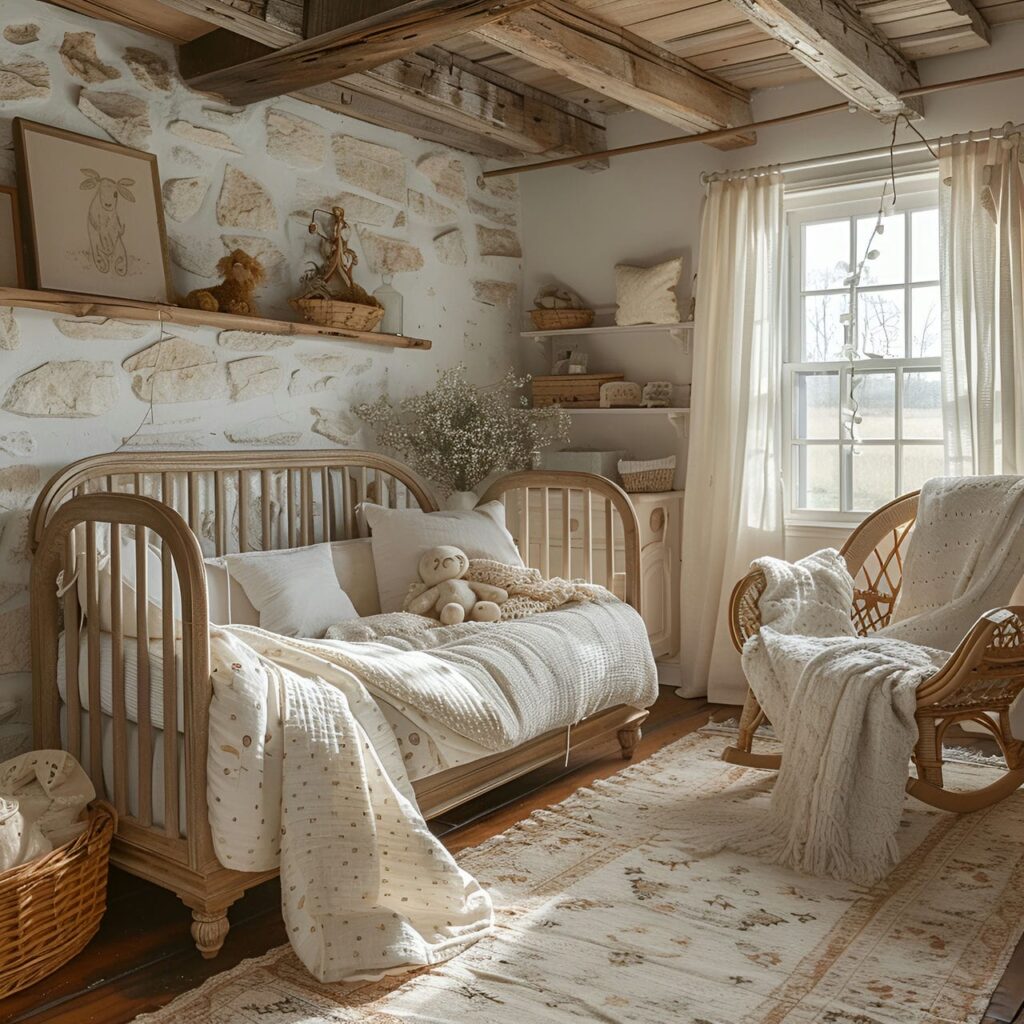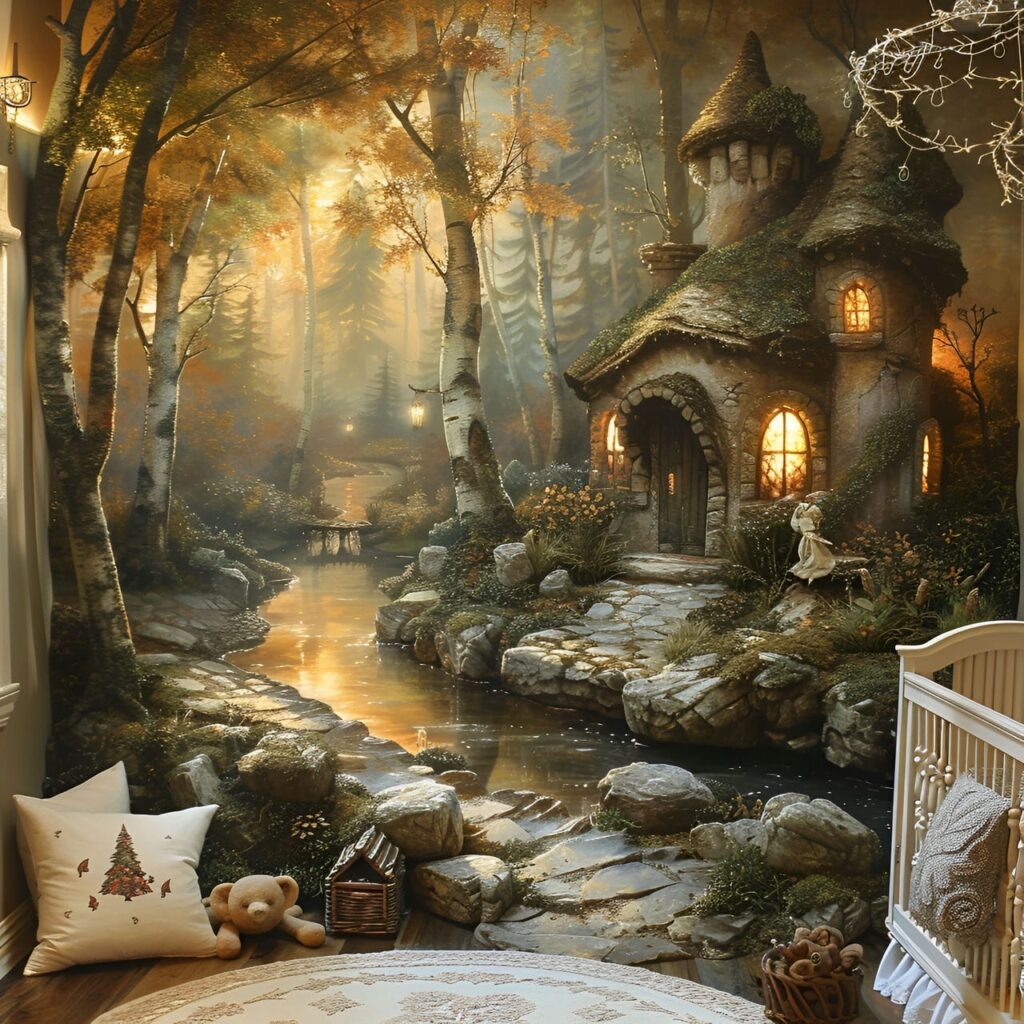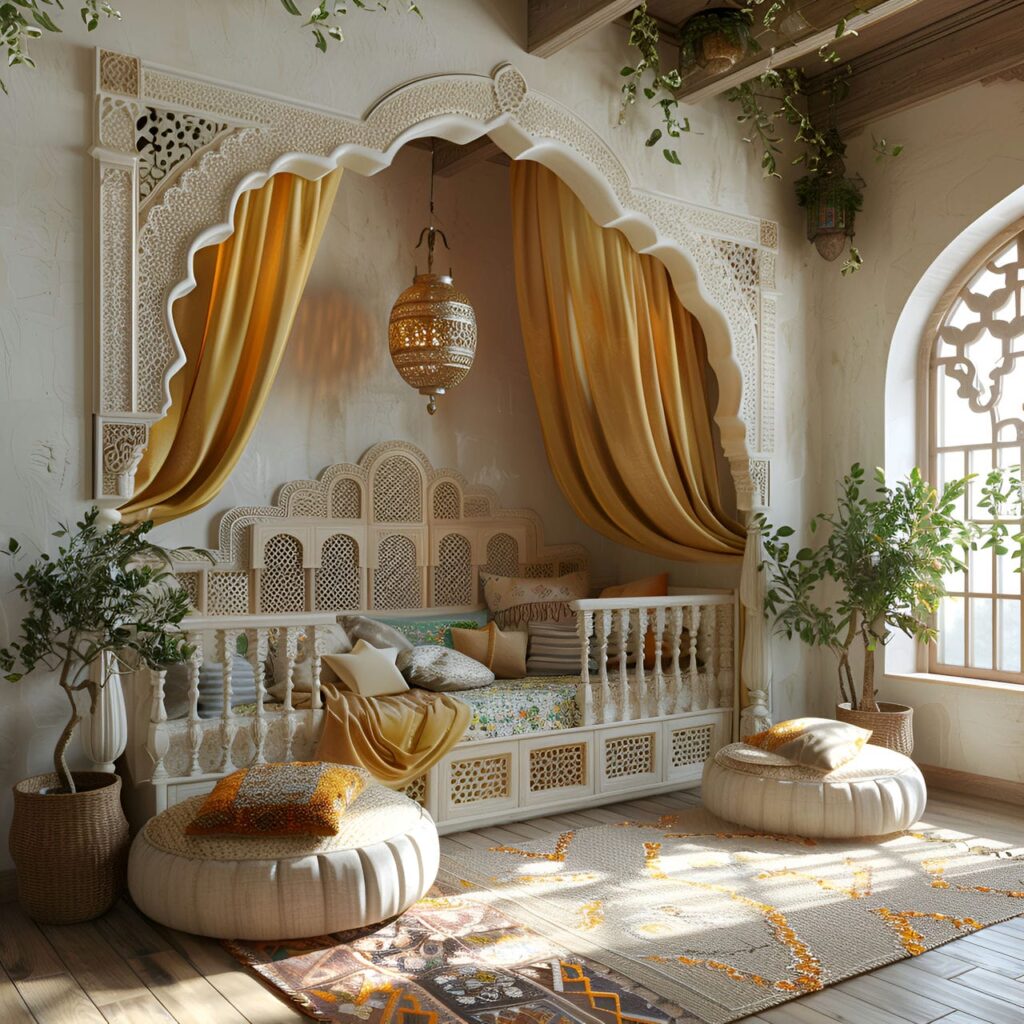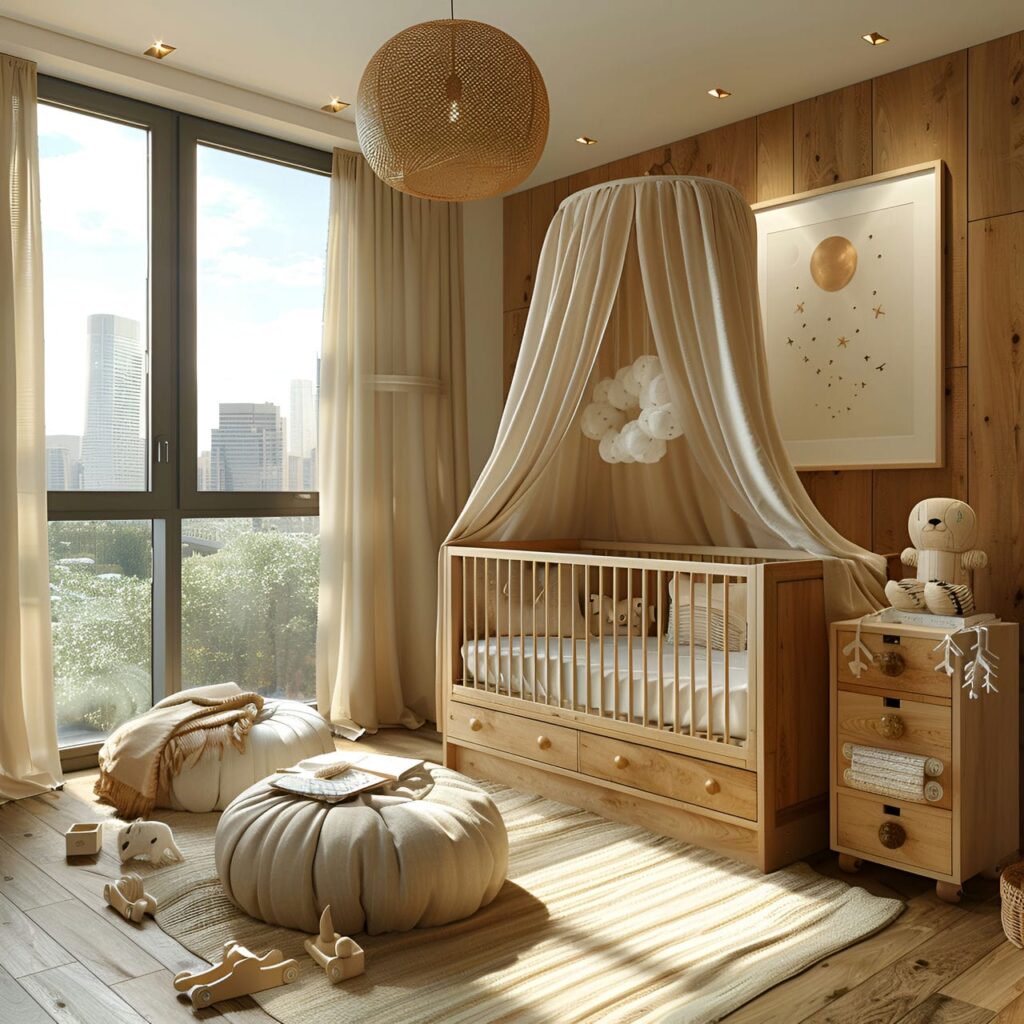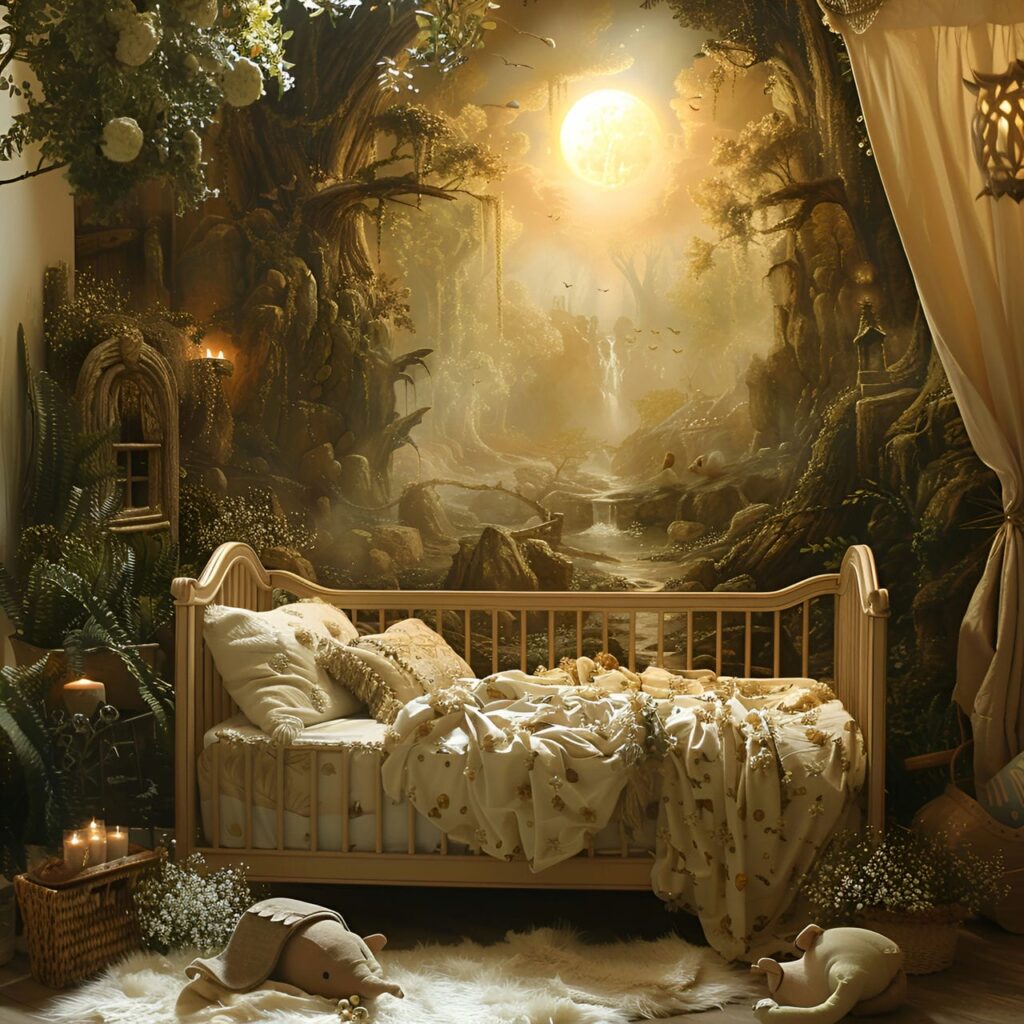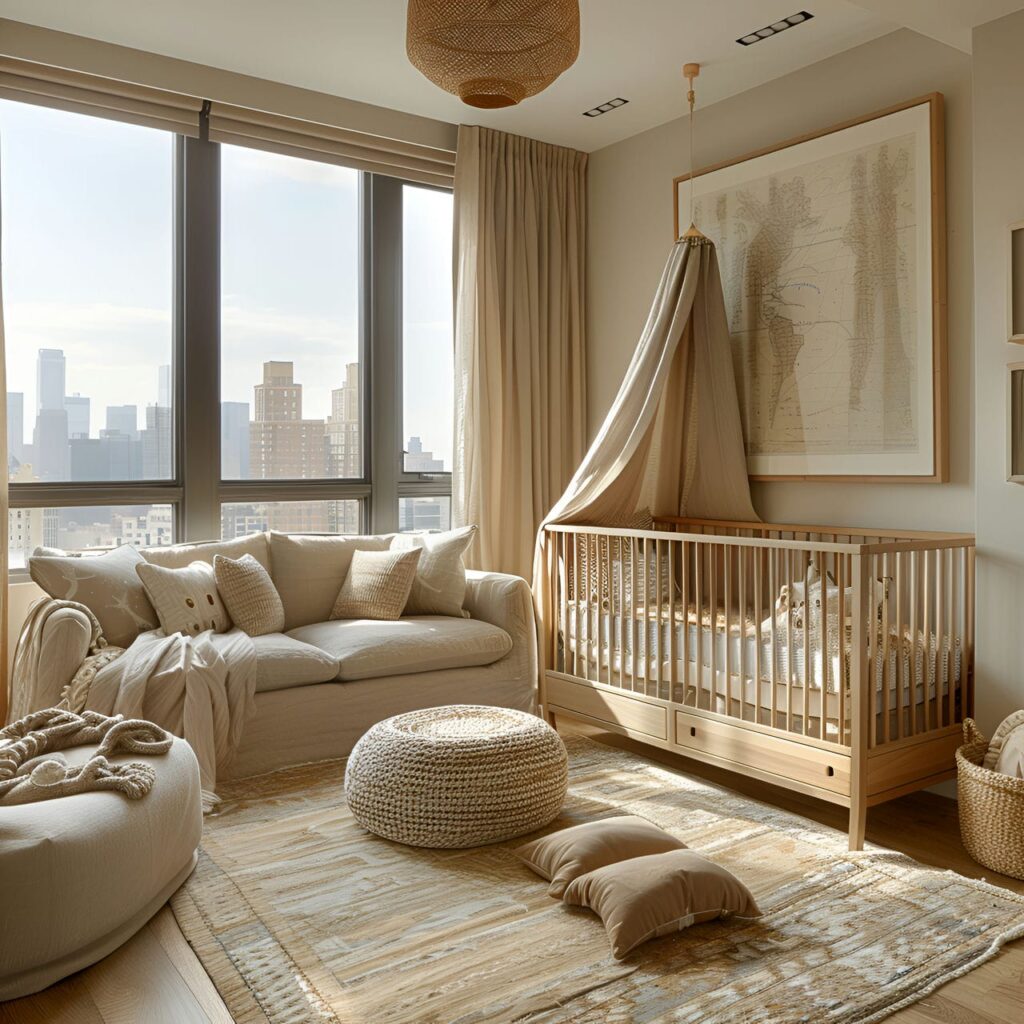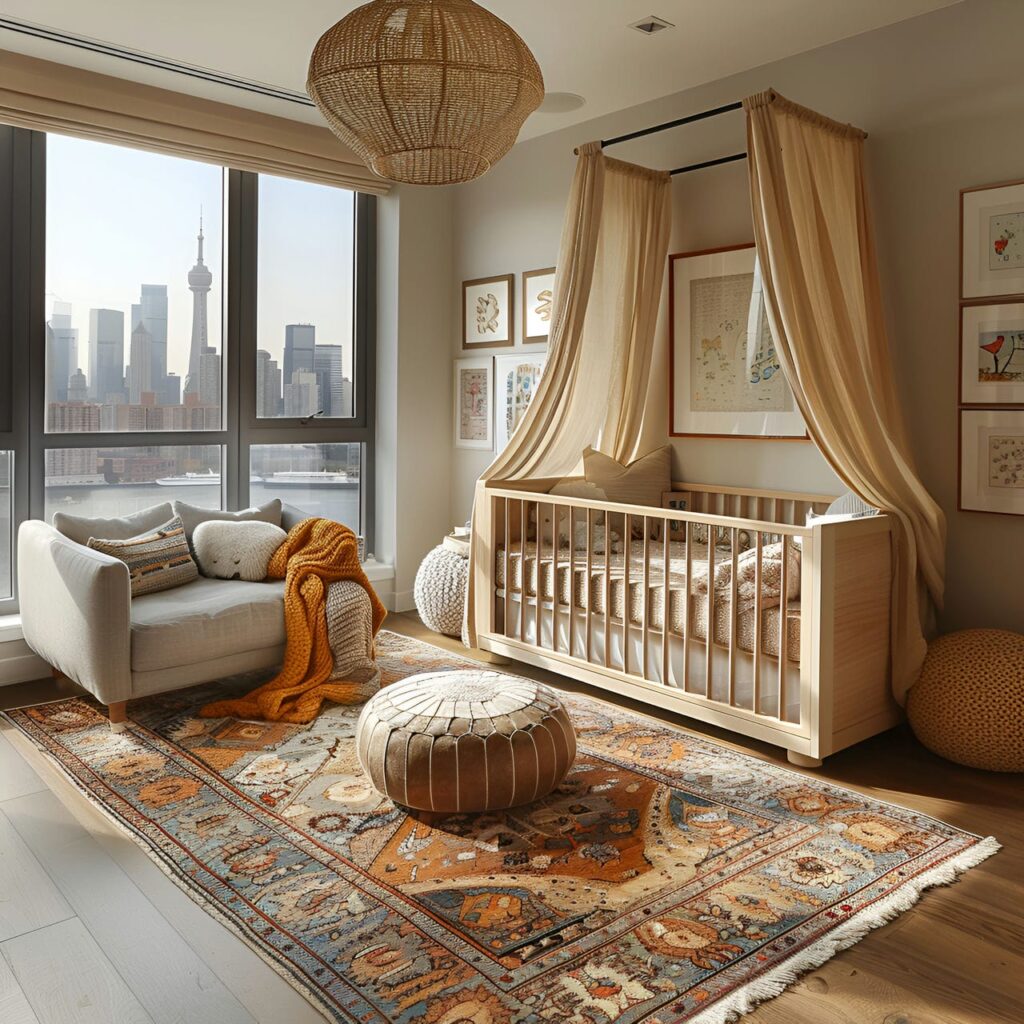Nursery rooms are important spaces in homes designed for infants and young children. These rooms measure between 200 to 240 square feet (18 to 22 square meters), with standard ceiling heights ranging from 8 feet (2.4 meters) to 9 feet (2.7 meters). This size accommodates important nursery furniture such as cribs, changing tables, and seating comfortably, ensuring functional space without feeling cramped. The layout is designed to fit these pieces while leaving room for movement and play. The primary purpose of a nursery is to provide a dedicated sleeping space for babies, centralized storage for baby items, privacy for caregiving and feeding, and mental separation between child and adult zones. Nursery rooms adopt a rectangular or square shape for functionality. These standard shapes, ranging from 11.5 feet (3.5 meters) to 18 feet (5.5 meters) in dimensions, maximize floor area and enable comfortable traffic patterns, accommodating necessary baby gear and furniture. Furniture in a nursery includes cribs, changing tables, dressers, rocking chairs or gliders, storage solutions, nightlights or lamps, and crib mattresses and bedding. Energy efficiency in nurseries is achieved through insulation, high-performance glazing, efficient lighting and controls, right-sized HVAC systems, and renewable energy sources. They are renovating a nursery, with costs ranging from $1,817 to $4,140 (€2,700 to €4,500, £2,300 to £3,800), covering cosmetic changes and important furniture. More extensive renovations, including structural changes or luxury finishes, can significantly increase costs. The cost of hiring an architect for a nursery renovation varies depending on the project’s complexity, typically ranging from $1,242 to $4,140 (€1,350 to €4,500, £1,150 to £3,800). Homeowners face several challenges when redecorating a nursery, including balancing function and style, the influence of social media, costs, choosing the suitable color scheme, room transformations, planning for future changes, and working within a limited budget. These factors require careful consideration to create a safe, functional, and aesthetically pleasing nursery.
What is the typical size of a nursery?
A typical nursery size is between 200 square feet (18 square meters) and 240 square feet (22 square meters), providing enough functional space for a new baby without feeling too cramped. Standard ceiling heights of 8 feet (2.4 meters) to 9 feet (2.7 meters) allow most basic nursery furniture to fit comfortably, like cribs ranging from 3.8 feet (1.15 meters) x 2 feet (0.65 meters) to 4 feet (1.3 meters) x 2.3 feet (0.7 meters) and changing tables 3 feet (0.9 meters) x 2 feet (0.6 meters). The layout fits important pieces such as a crib, changing station, rocking chair, or seating 2.6 feet (0.8 meters) x 2.3 feet (0.7 meters) and a dresser 3 feet (0.9 meters) x 1.6 feet (0.5 meters). This leaves reasonable room for accessing furniture and some open floor area. Spacious luxury home nurseries exceed 320 square feet (30 square meters), with some reaching 645 square feet (60 square meters) or more. Ceiling heights begin at 8 feet (2.4 meters) and can go up to 10 feet (3 meters) or higher. There is ample area for oversized cribs up to 4.9 feet (1.5 meters) x 2.6 feet (0.8 meters) and wide 3.3 feet (1 meter) x 2 feet (0.6 meters) changing tables. The expanded footprint allows for fitting additional furniture like 3.3 feet (1 meter) to 4.9 feet (1.5 meters) storage cabinets, bookcases, toy boxes, and activity centers while still having plenty of open floor space.
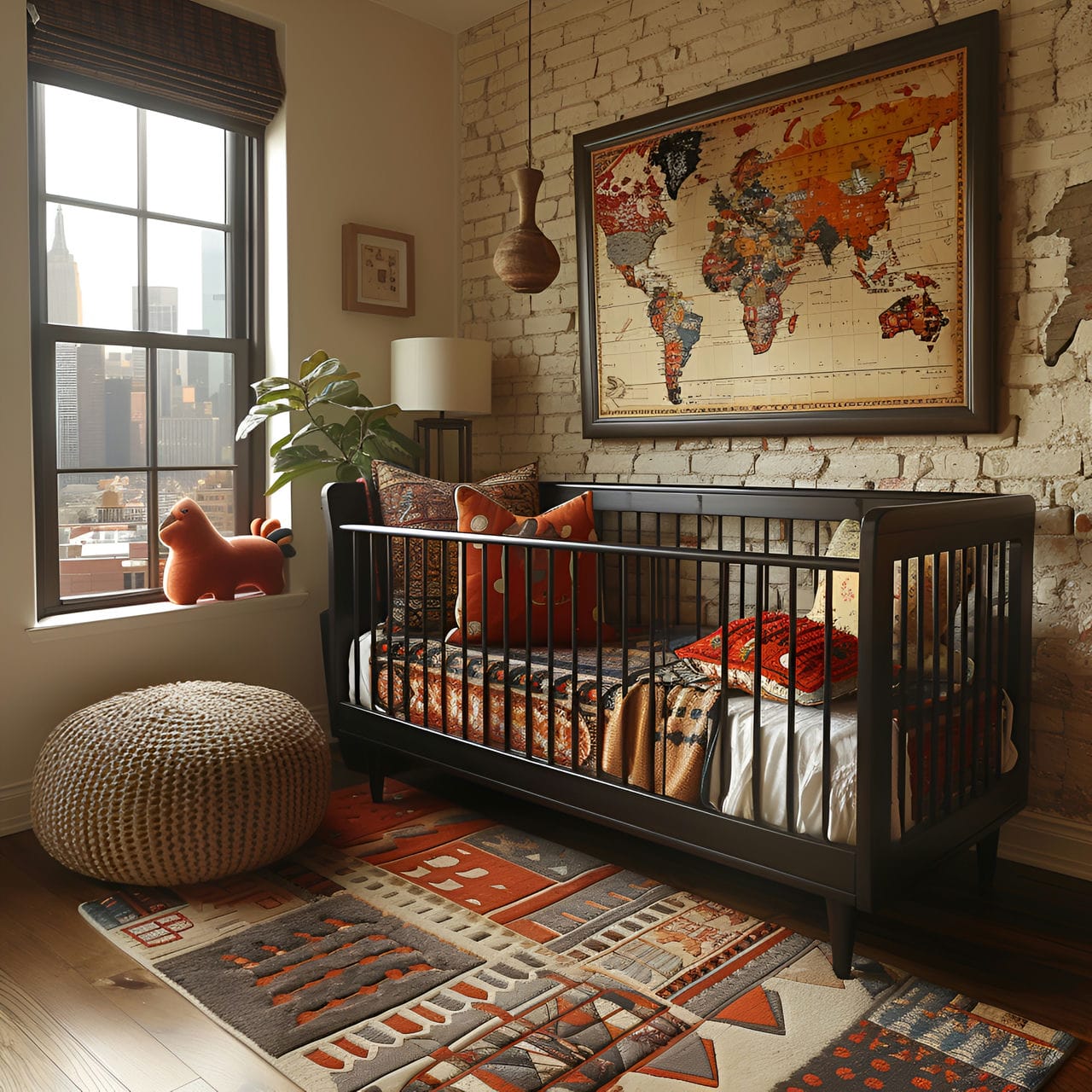
What is the use and purpose of a nursery?
The purpose of a nursery is to provide a dedicated sleeping space for babies, centralized storage for baby items, privacy for caregiving and feeding, and mental separation between the kid zone and the adult zone. Firstly, a nursery provides a safe, dedicated space for a baby to sleep, especially during the first 6-12 months, when it is recommended that babies sleep in the same room as their parents to reduce the risk of SIDS. Secondly, the nursery contains all the supplies, furniture, toys, books, and other gear needed for the baby’s care. Confining baby paraphernalia to the nursery helps keep the rest of the home tidy and uncluttered. Thirdly, nurseries allow privacy for feeding, diapering, and special bonding moments between parents and babies. A comfortable chair, subdued lighting, and freedom from distractions facilitate relaxation for both baby and tired new parents during night wakings or long days at home. Lastly, nurseries provide mental separation between parental and baby spaces. Baby monitors, and an open door maintain the safety and supervision required in the early months.
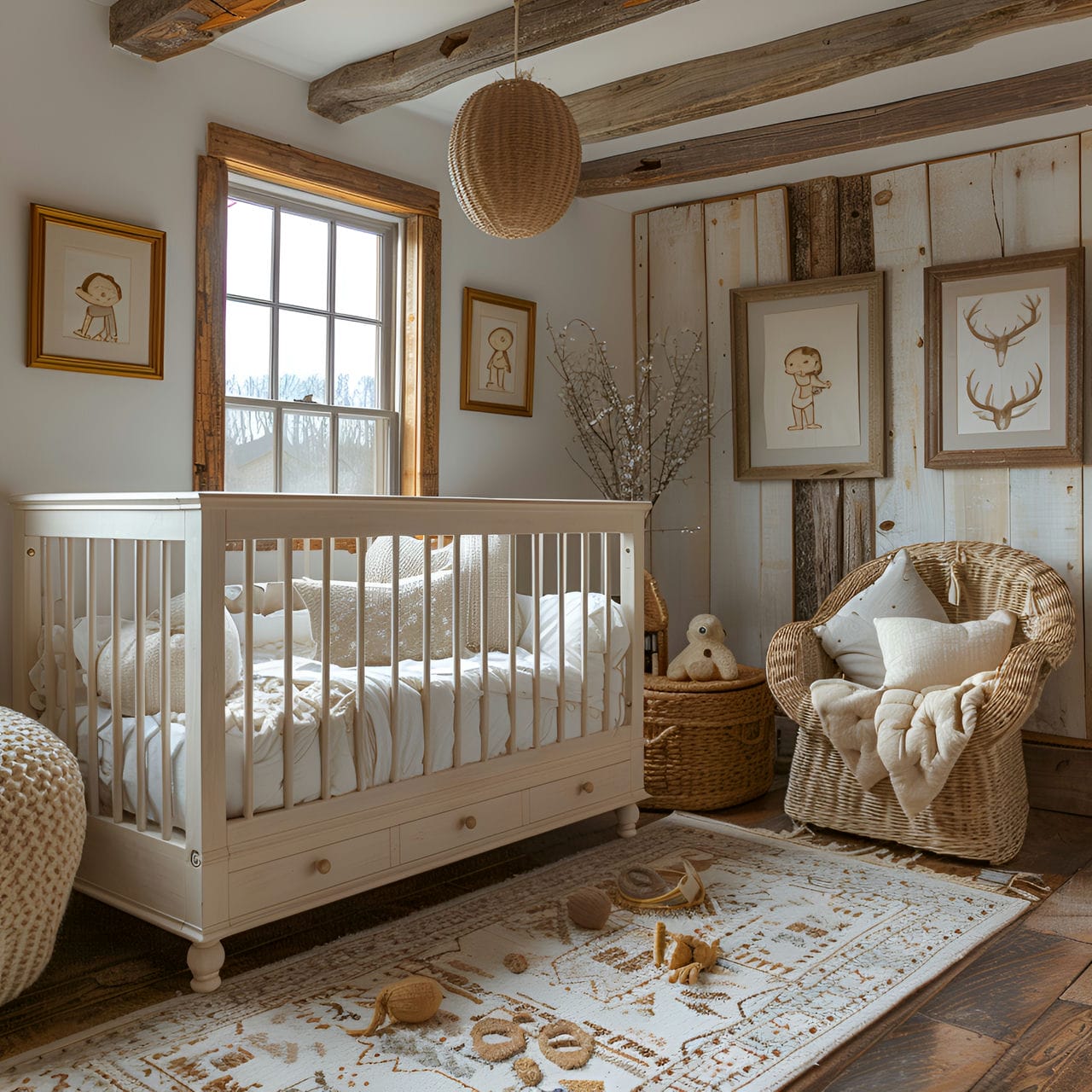
What is the typical shape of a nursery?
The typical shape of a home nursery room is a rectangle or square due to the functionality of these layouts. Standard rectangular nurseries range from 11.5 feet (3.5 meters) to 15 feet (4.5 meters) in width, allowing space for a crib against the longer wall. The depth spans a longer 15 feet (4.5 meters) to 18 feet (5.5 meters) for ample clearance around more significant pieces of furniture. Square nurseries are commonly 13 feet (4 meters) to 16 feet (5 meters) on each side, keeping the crib and seating accessible. Both standard layouts maximize floor area for necessary baby gear while enabling comfortable traffic patterns. More elaborate nursery shapes and architectural details are sometimes seen in upscale custom designs.
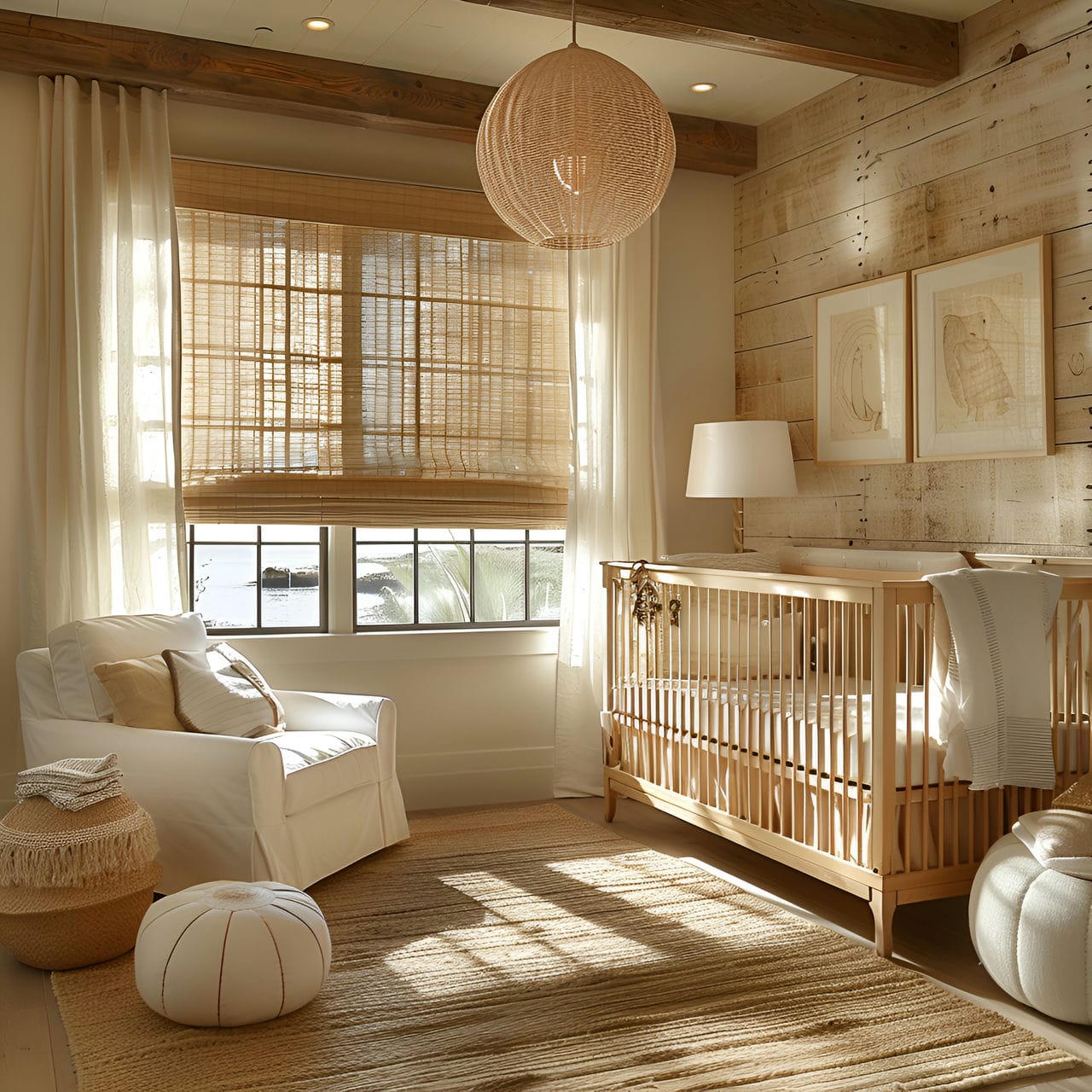
What furniture commonly equips a nursery?
Listed below are the types of furniture commonly equip a nursery:
- Crib: The crib is an important piece of furniture in a nursery. It provides a safe and comfortable place for the baby to sleep. Modern cribs comply with safety standards, ensuring that the slats are no more than 2.6 feet (0.8 meters) x 2.3 feet (0.7 meters) above the mattress and corner posts are no more than the height above the frame.
- Changing Table: A changing table in the nursery is a practical piece of furniture that provides a convenient place to change the baby’s diapers. Some changing tables have built-in storage for diapers, wipes, and other necessities. A dresser can be converted into a changing table by adding a changing pad on top.
- Dresser: A dresser is important furniture in the nursery for storing the baby’s clothes and other items. Choosing a dresser that can accommodate more oversized clothes as the baby grows is advisable. Some dressers can also double as a changing table, providing a space-saving solution.
- Rocking Chair or Glider: A rocking chair or glider is a piece of furniture that provides a comfortable place for nursing and can help lull the baby to sleep. It is also an excellent place for parents to relax in the nursery. Some models come with matching ottomans for added comfort.
- Storage Solutions: Organizational storage bins or toy shelves are necessary furniture for the nursery to manage the baby’s toys, books, and other items. Baskets or bins can be used for storing diapers and other baby necessities. A bookshelf can be a valuable addition to the nursery, providing a place to display books and decorative items.
- Nightlight or Lamp: A nightlight or lamp with a dimmer is a valuable piece of furniture for a nursery. It provides soft lighting for middle-of-the-night feedings and diaper changes without disturbing the baby’s sleep. Some lamps also come with built-in nightlights.
- Crib Mattress & Bedding: A firm, flat mattress that fits snugly in the crib is important furniture in the nursery for the baby’s safety and comfort. The bedding should be washable and durable. Crib sheets are necessary to protect the mattress and provide a soft surface for the baby to sleep on.
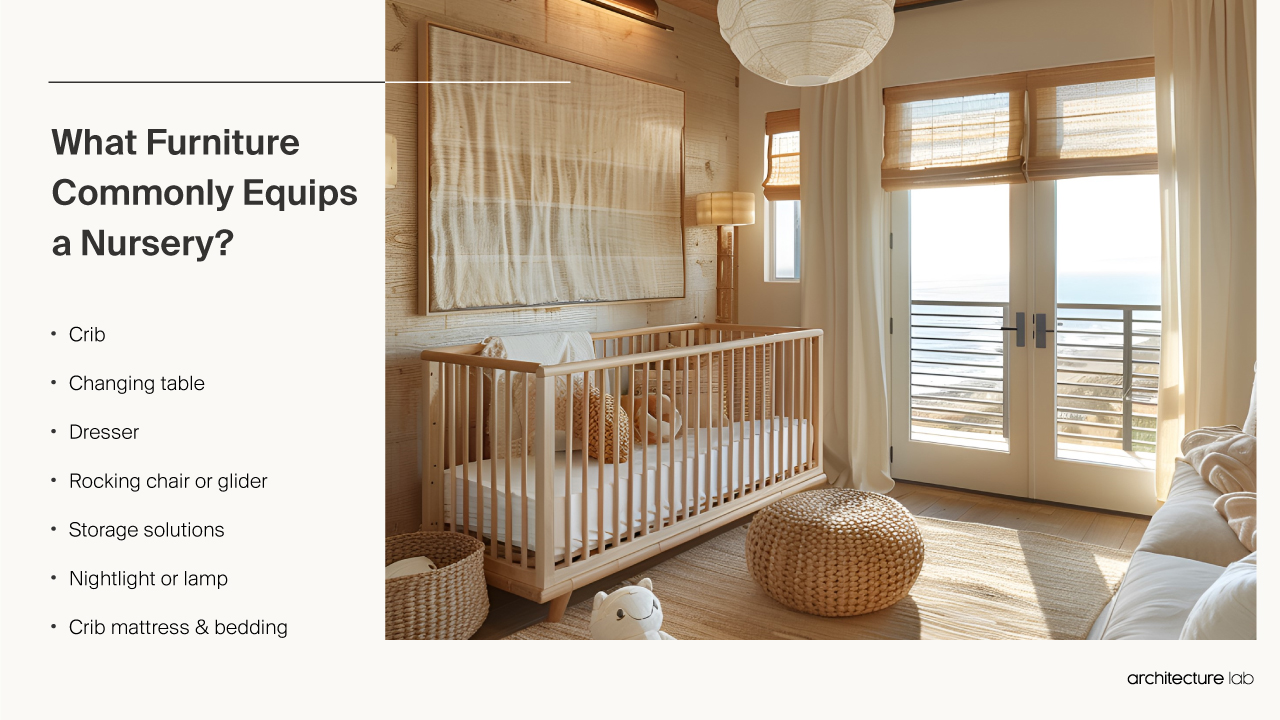
What is the normal ceiling height of a nursery?
The normal ceiling height of a nursery ranges from 8 feet (2.4 meters) up to 9 feet (2.7 meters). Average nursery ceiling heights span 8 feet (2.4 meters) to 8 feet 3 inches (2.5 meters), providing ample space to accommodate a crib, small furniture, and proper clearances. Luxury nursery ceiling heights start at 8 feet 3 inches (2.5 meters) going up to 9 feet (2.7 meters). The elevated ceiling height incorporates full-size changing tables, more oversized dressers or cabinets, and specialty decor elements. Extra height can add a sense of openness, and considerations for safety, furnishings, storage, and design often make standard ceilings suitable over the necessary footprint typical of a sized home nursery.
What colors are nursery rooms usually painted?
Listed below are the colors usually used in nursery rooms painted:
- Pastel Colors: Pastel colors, such as light pinks, blues, and greens, are often chosen for nurseries because they create a soothing environment. These soft, muted shades are gentle on the eyes and can help promote a peaceful atmosphere, which benefits both the baby and the parents.
- White: White is a popular choice for nurseries due to its association with purity and innocence. This color creates a clean, fresh ambiance, making the room feel more spacious and welcoming. White is also a blank canvas, allowing accent colors and decor flexibility.
- Neutral Tones: Neutral colors like beige, taupe, and gray are often chosen for their versatility. This color brings warmth and depth to the space and plays nicely with décor that’s white, black, or in a complementary color. Neutral tones also provide a sophisticated backdrop.
- Yellow: Yellow is a cheerful and optimistic color that can brighten up a nursery. This color is a light, buttery shade of yellow that is often used to create a sunny and welcoming environment. Choosing a soft, muted yellow rather than a bright, intense shade is important to ensure the color is soothing rather than stimulating.
- Coral and Mint: Modern design trends encourage breaking traditional color norms and experimenting with various colors. Coral and mint, paired with sweet pinks or lilac, can create delightful nurseries.
- Bold Dark Colors: Bold colors like dark navy, olive green, and black can create a dramatic and sophisticated look in a baby nursery. Using these colors on an accent wall can add depth and dimension to the space. Balancing these bold colors with lighter tones is important to prevent the room from feeling too dark or overwhelming.
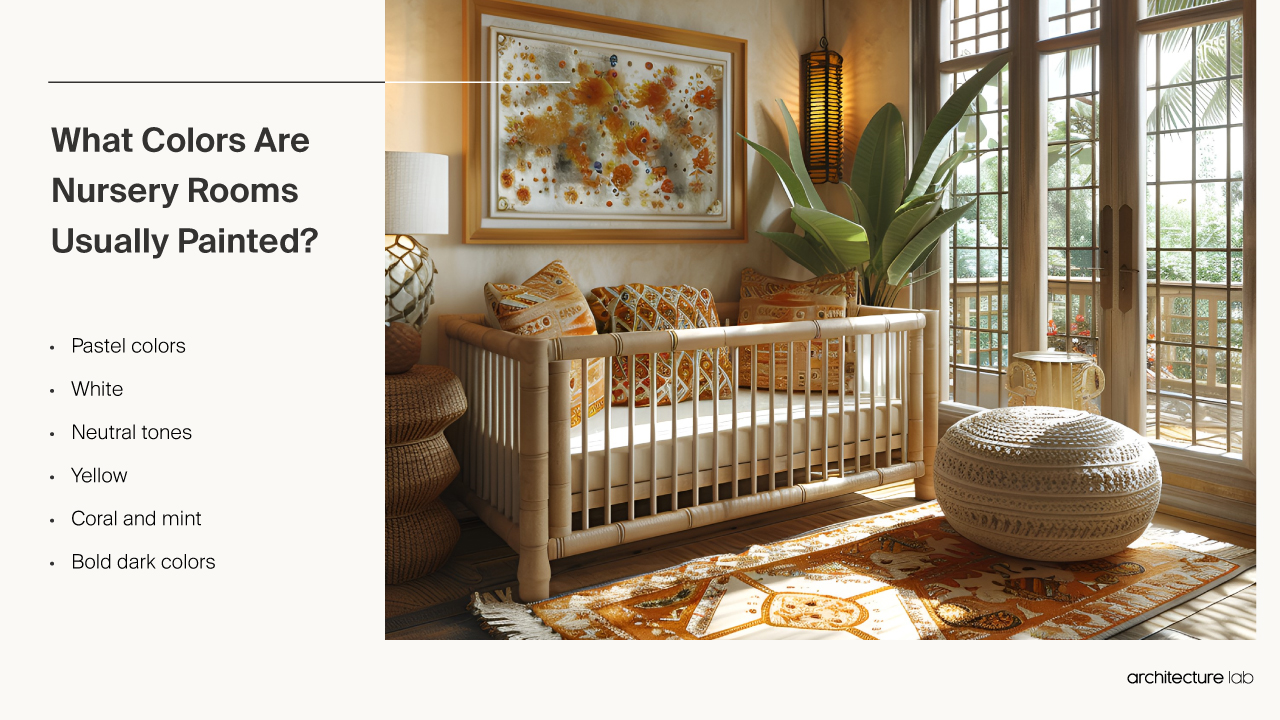
What makes the nursery functional?
The nursery is functional by incorporating adaptable organization, multi-use furniture, resilient materials, and an open floor plan to accommodate parenting tasks. Firstly, proper organization and storage help maximize functionality. Designating zones for critical functions like diapering, feeding, sleeping, and playing keeps related gear handy. Built-ins, baskets, bins, and corral supplies ensure necessities are accessible. Secondly, multi-purpose pieces enhance utility in modest nurseries. Dressers double as changing tables, then convert to storage as kids grow. Cubbies transition from book displays to toy bins to display shelves. Pieces doing double duty optimize the space. Thirdly, durable finishes withstand heavy use, facilitating cleanliness and safety. Waterproof changing pads, stain-resistant rugs, and scrubbable upholstery handle messes. Soft corners on furnishings protect babies just learning to cruise. Durable details mean parents can focus on caregiving rather than fretting over finishes. Lastly, an open layout allows supervision from multiple vantage points, which is especially helpful when tackling chores or working from home. Sightlines to key areas give parents peace of mind. Keeping the nursery nearby also enables tending to the baby while maintaining proximity to other kids.
How is energy efficiency achieved in a nursery?
Energy efficiency is achieved in a nursery through insulation, high-performance glazing, efficient lighting/controls, right-sized HVAC, and renewables. Firstly, proper insulation and sealing of the nursery is vital to preventing heat loss and maintaining comfortable temperatures. Installing fiberglass or mineral wool insulation rated R-38 or higher in exterior walls and ceilings ensures efficiency. Secondly, installing energy-efficient windows, preferably triple pane, reduces greenhouse transfer. Insulated window treatments add further efficiency. Automated exterior solar shades prevent overheating from sunlight. Thirdly, energy-efficient LED lighting reduces electricity consumption by up to 80% compared to incandescent bulbs. Computerized controls that turn lights on/off based on occupancy or daylight levels also cut waste. Fourthly, HVAC systems sized appropriately for nursery spaces enable precise climate control without overworking the system. Ductless mini-split heat pumps provide heating/cooling without duct losses. Lastly, on-site solar power from rooftop panels provides sustainable supplemental electricity on sunny days. Solar water heating reduces the demand for utility-supplied hot water.
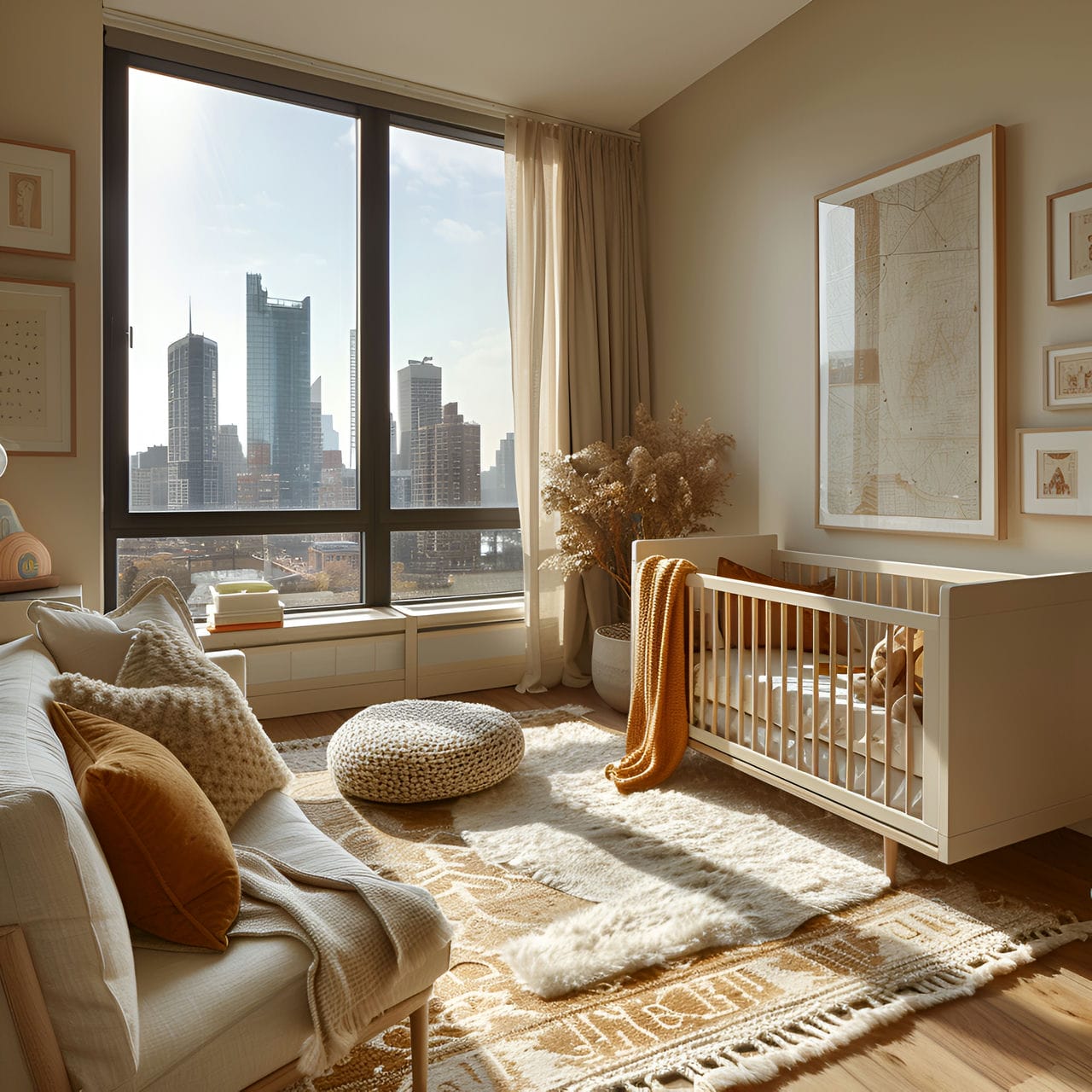
How much does it typically cost to renovate a nursery?
The average cost to renovate an existing room into a nursery ranges between $3,000 (€2,700, £2,300) and $5,000 (€4,500, £3,800). This budget allows for cosmetic changes like painting, installing new flooring, updating lighting fixtures, and adding accent walls or murals to transform the space visually. Typical nursery renovations include structural modifications like removing or installing closets, adjusting the room layout, and possibly expanding the footprint, which raises costs closer to $5,000 (€4,500, £3,800) or beyond. All vital furniture like cribs, dressers, changing tables, and rocking chairs/gliders must be purchased separately and can range from $800 (€720, £600) up to $3,000 (€2,700, £2,300) depending on style and quality. For a top-to-bottom renovation converting an existing bedroom or office into a complete nursery with higher-end finishes, furnishings, and storage, expect costs between $10,000 (€9,000, £7,600) to $15,000 (€13,500, £11,400). Maximum budgets over $20,000 (€18,000, £15,200) allow for significant layout changes, bathroom additions, custom cabinetry, and design elements like mural walls or specialty lighting. Regional construction rates cause fluctuation, but typical costs for most standard nursery room renovations fall between $3,000 (€2,700, £2,300) and $5,000 (€4,500, £3,800) with all new important furniture included. More lavish nurseries with high-end details, finishes, and square footage can exponentially increase budgets to $20,000+ (€18,000+, £15,200+).
What factors affect the nursery renovation?
Listed below are the factors that affect the nursery renovation:
- Safety Considerations: Safety is paramount in a nursery renovation. This includes ensuring adequate natural and indoor lighting, good ventilation, and a comfortable temperature. The materials used in the renovation should be easy to install and renew and have heat insulation, sound insulation, and sound absorption performance.
- Space Planning: The nursery layout should be as compact as possible to minimize the boundary length and reduce the time lost moving from one part of the nursery to another. The design should also consider possible future expansion of facilities and staff.
- Climate and Soil Considerations: The climate and soil conditions can influence the nursery renovation, mainly if the nursery includes a garden or outdoor area. The nursery design should be tailored to meet specific climate conditions and soil workability and drainage.
- Water Supply: The availability and quality of the water supply are crucial factors in nursery renovation. This is particularly relevant if the nursery includes a garden or plants that require regular watering.
- Cost and Budget: The cost of land and the budget for the renovation can significantly affect the nursery renovation. Establishing a realistic budget and keeping track of expenses throughout the renovation process is essential.
- Proximity to Services: The nursery’s proximity to customers, labor, and services can influence the renovation process. If the nursery is far from suppliers or contractors, this could add to the cost and complexity of the renovation.
- Quality of Nursery Facilities and Staff: The quality of nursery facilities and staff can impact the renovation process. Poorly managed nurseries may need help to perform well during the renovation.
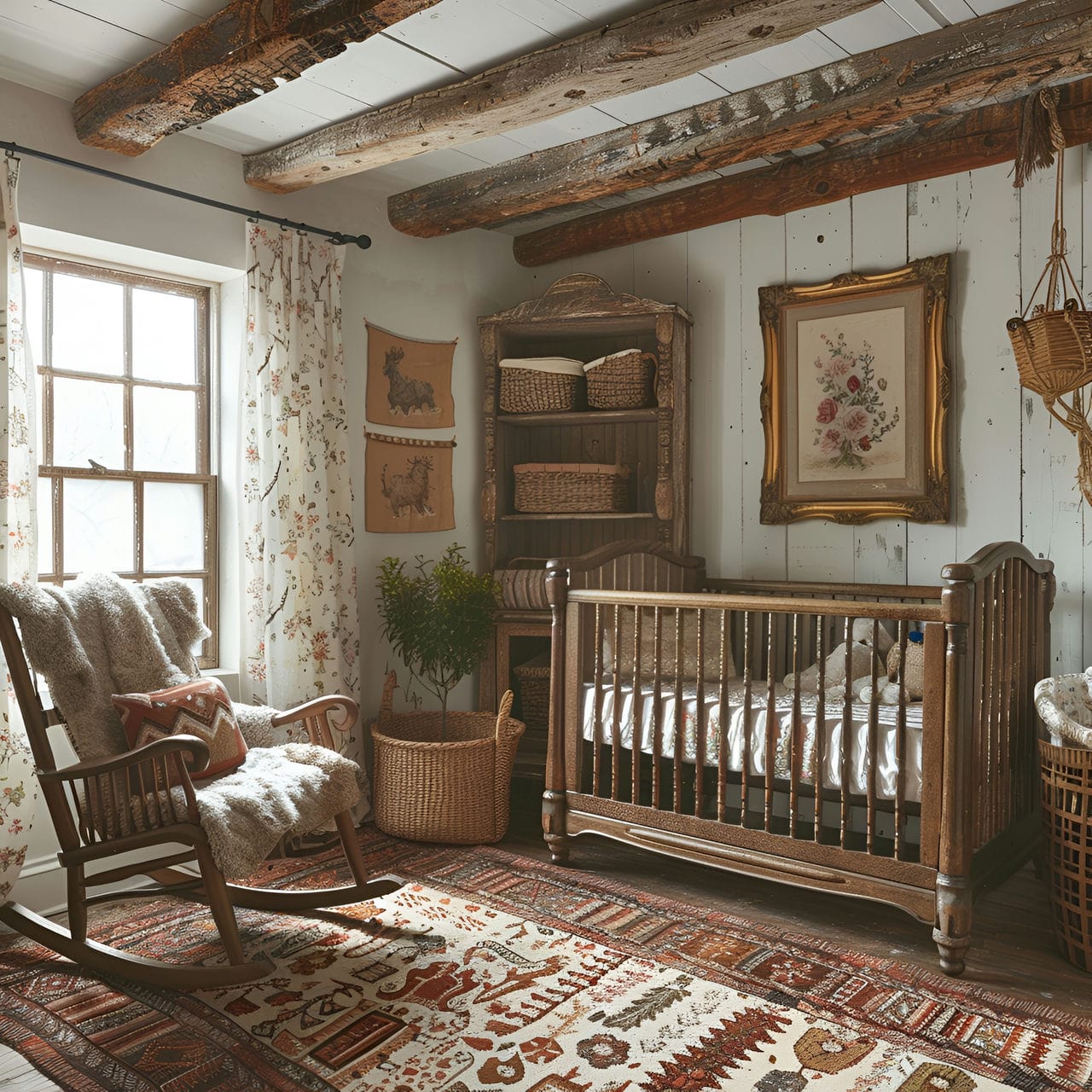
Is an architect required to renovate a nursery?
No, an architect is not required to renovate a nursery but it is recommended. Architects are trained to understand building codes, safety regulations, and design requirements specific to spaces for young children. They can ensure all legal standards are met. They can rework room layouts to improve supervision lines, integrate smart multifunctional zones, and specify durable finishes/fixtures suitable for little kids. Architects stay current on innovations like soundproofing, eco-friendly materials, modular furniture pieces, and storage solutions that stand the test of time through growth milestones. For structural changes like moving walls, adding extensions/dormers, or converting unfinished spaces, an architect ensures the structural integrity and proper nursery environment. Architects can also help match designs for cohesiveness if integrating a new nursery within an existing home layout and decor.
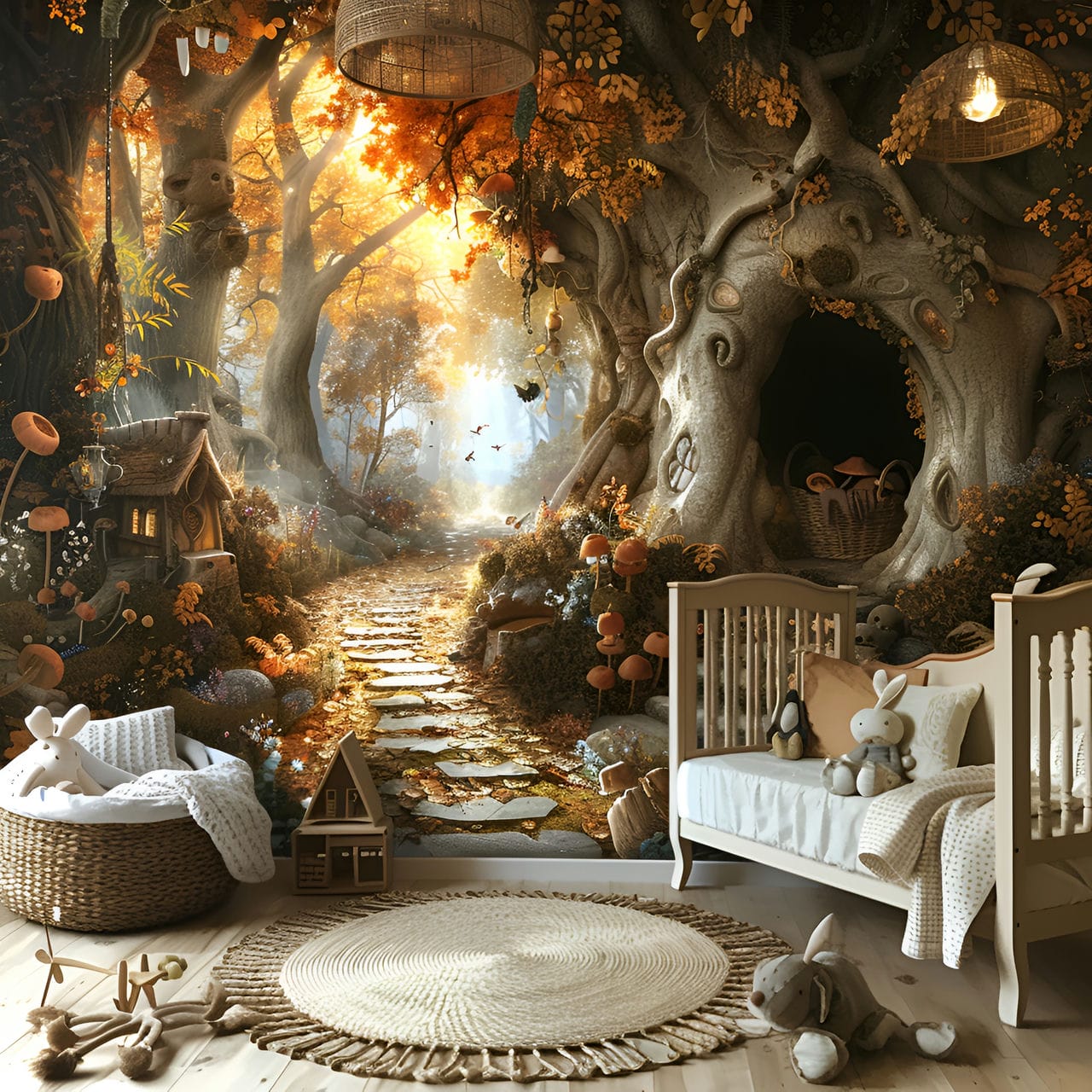
How can an architect help you upgrade a nursery?
Listed below are the ways that an architect can help an owner upgrade a nursery:
- Design Expertise: An architect can provide design expertise tailored to a nursery’s needs. They can create a strategic brief that outlines the core project requirements, such as the number and size of rooms, and the vision and aims for the space. They can make the space efficient, which can help reduce long-term operational costs.
- Regulatory Compliance: Architects are knowledgeable about fire safety codes, zoning regulations, and building regulations that will affect the design and location of the nursery. They can navigate these complex requirements and ensure the nursery renovation or construction complies with all legal standards. This helps to avoid potential legal issues and ensures the safety and well-being of the children and staff.
- Innovative Play Environments: Architects can design creative play environments that support early childhood development. Architects can create spaces that promote creativity and active play by incorporating elements like nature and adaptable playground equipment.
- Event-Ready Spaces: An architect can design a versatile nursery that can host events. Features such as sliding doors and high ceilings can be transformed to serve multiple purposes, such as small hall-like gathering areas. This flexibility can make the nursery a more valuable and multi-functional community asset.
- Safety and Comfort: Architects can design nurseries that are safe havens for children, providing a cocoon-like sanctuary that insulates users from external stressors. The design can include considerations for complex or dangerous household backgrounds, ensuring the nursery is secure.
- Flexible Room Layouts: Architects can create flexible room layouts that can change to accommodate various sizes and functions. This allows the nursery to adapt to different activities, such as playing and learning areas. A well-thought-out design can enhance the learning experience and provide a space responsive to the children’s changing needs.
- Child-Centric Design: Architects can ensure that the nursery design is child-centric, considering the complex needs of early childhood. They can move beyond traditional typologies to create spaces that truly serve as an added educator, enhancing positive learning of behaviors, skills, attitudes, and values.
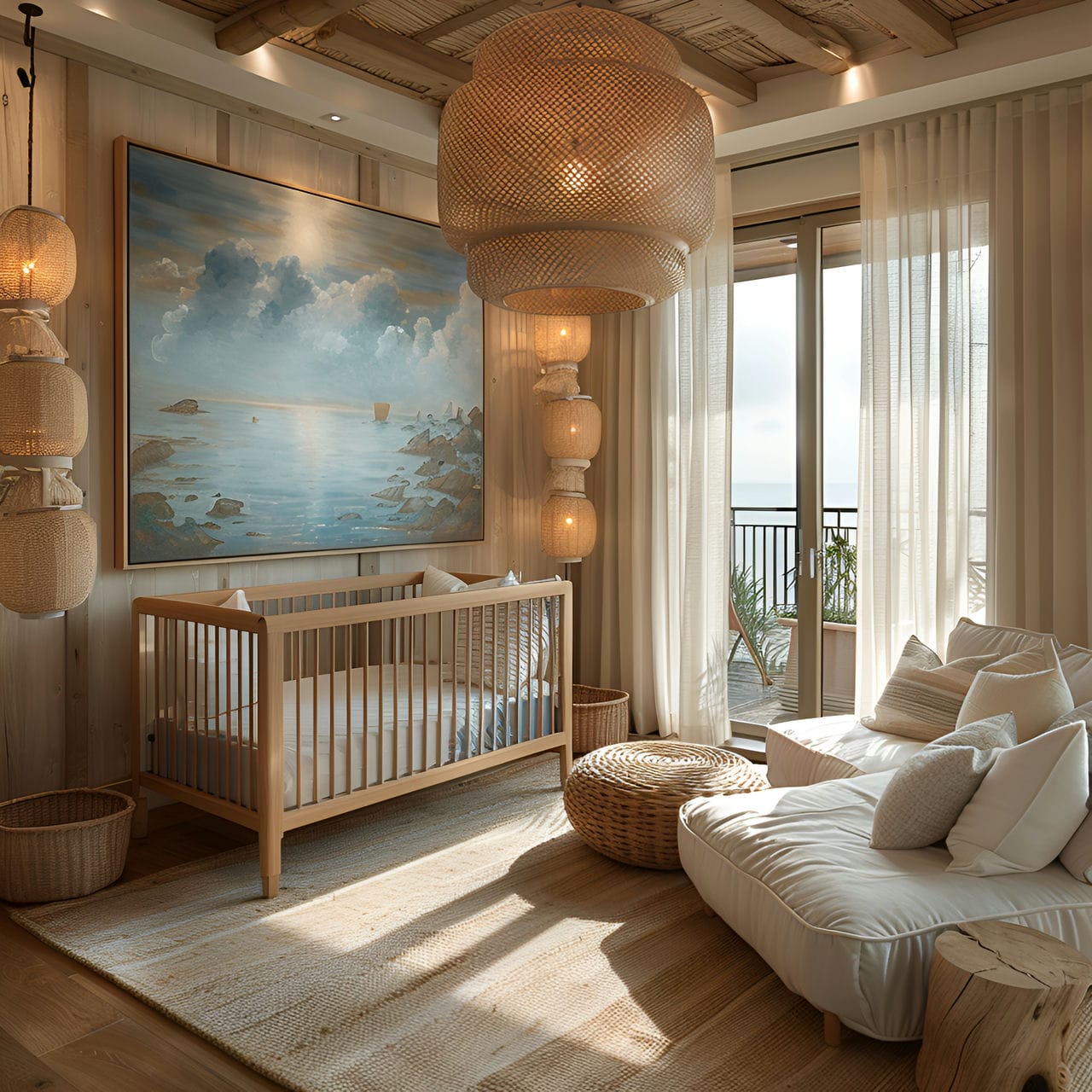
How much does it cost to hire an architect to renovate a nursery?
The average cost to hire an architect for designing a custom residential nursery renovation ranges from $1,500 (€1,350, £1,150) on the low end up to $5,000 (€4,500, £3,800) on the high end, based on project specifications. Most architects charge between $80 (€72, £60) to $150 (€135, £115) per hour for their services. A standard nursery renovation involving structural changes like moving walls or closets but still using the existing footprint could require 15-25 hours for the design work. This totals $2,000 (€1,800, £1,500) for a straightforward but unique nursery layout. More complex renovations that significantly alter spaces, like combining two small rooms, adding custom built-ins or specialty lighting, incorporating theme elements, or working in luxury furnishings, can take 30 hours or more of design time at $3,000 (€2,700, £2,300) on average. Top-tier interior designers or architects who provide nurseries with high-end details and customization might charge over $5,000 (€4,500, £3,800). Additional costs come from engineering consultants or contractors they work with as well.
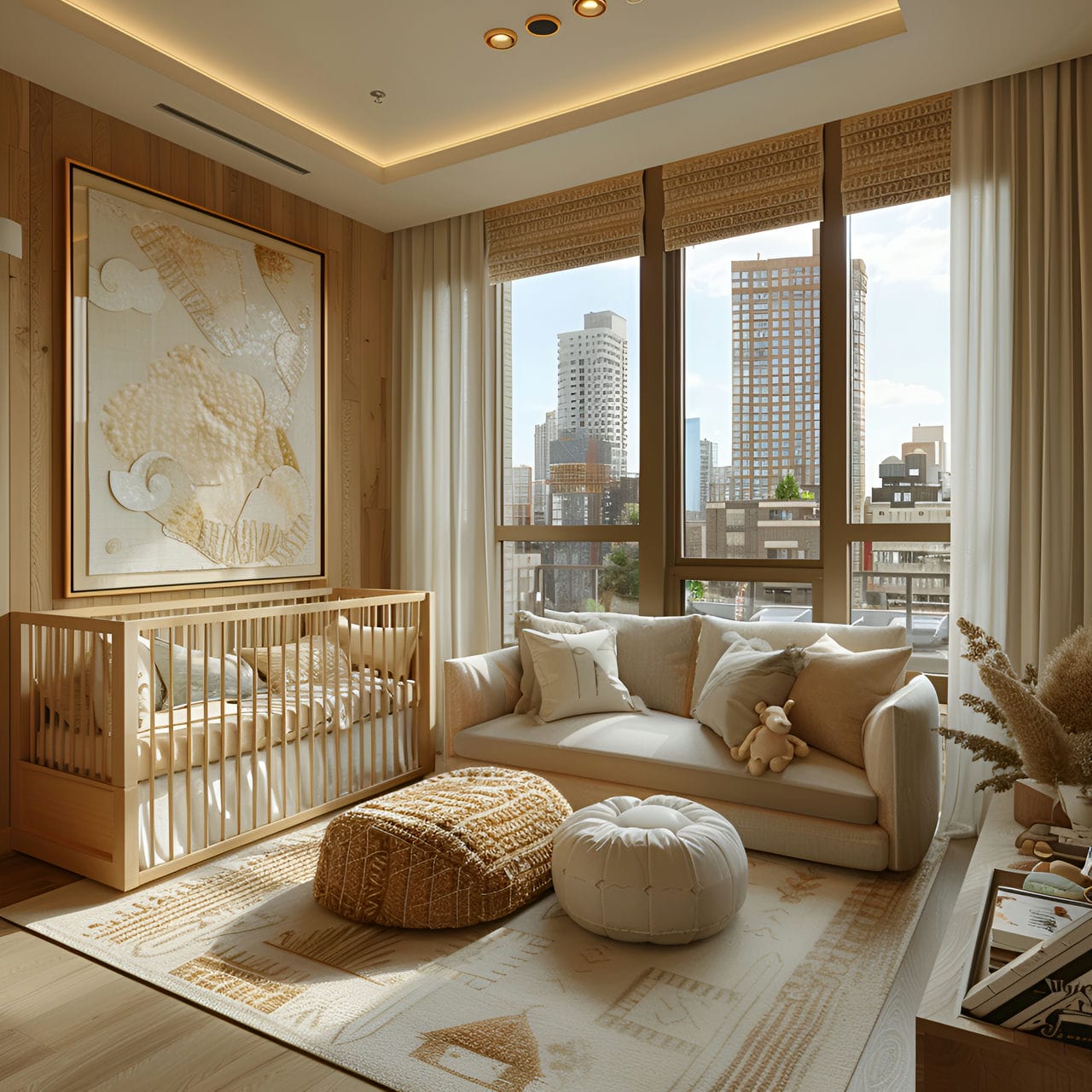
Is it worth it to hire an architect to upgrade a nursery?
Yes, hiring an architect to upgrade a nursery is worth considering, especially for tailored, functional designs. An architect’s expertise ensures the most efficient use of space, which is crucial in nurseries. They provide innovative storage, safety, and comfort solutions, vital in a child’s early years. Architects can future-proof the room, designing it to evolve with the child’s growing needs. This approach can be cost-effective in the long term, avoiding frequent redesigns. The initial cost may be higher, but the benefits of a professionally designed, adaptable, and safe nursery often outweigh the expense.

How long is needed to redecorate a nursery?
2 to 4 weeks are needed to redecorate the nursery. Firstly, the timeline for redecorating a nursery depends significantly on the scope of work. Cosmetic updates like fresh paint, new flooring, and minor furnishings can be accomplished in 2 to 4 weeks. More extensive renovations involving layout changes, custom built-ins, wiring updates, etc., range from 8-12 weeks. Secondly, procuring specialty nursery items like cribs, gliders, and dressers often involves lead times that extend projects. Custom upholstery and bedding also take additional production time once ordered. Careful planning and ranking well in advance are critical. Lastly, safety considerations may add time for nursery renovations. Special ventilation precautions are needed to avoid fume exposure when refinishing or painting. New wiring must be properly grounded and GFCI protected. Such safety compliance causes minor delays.
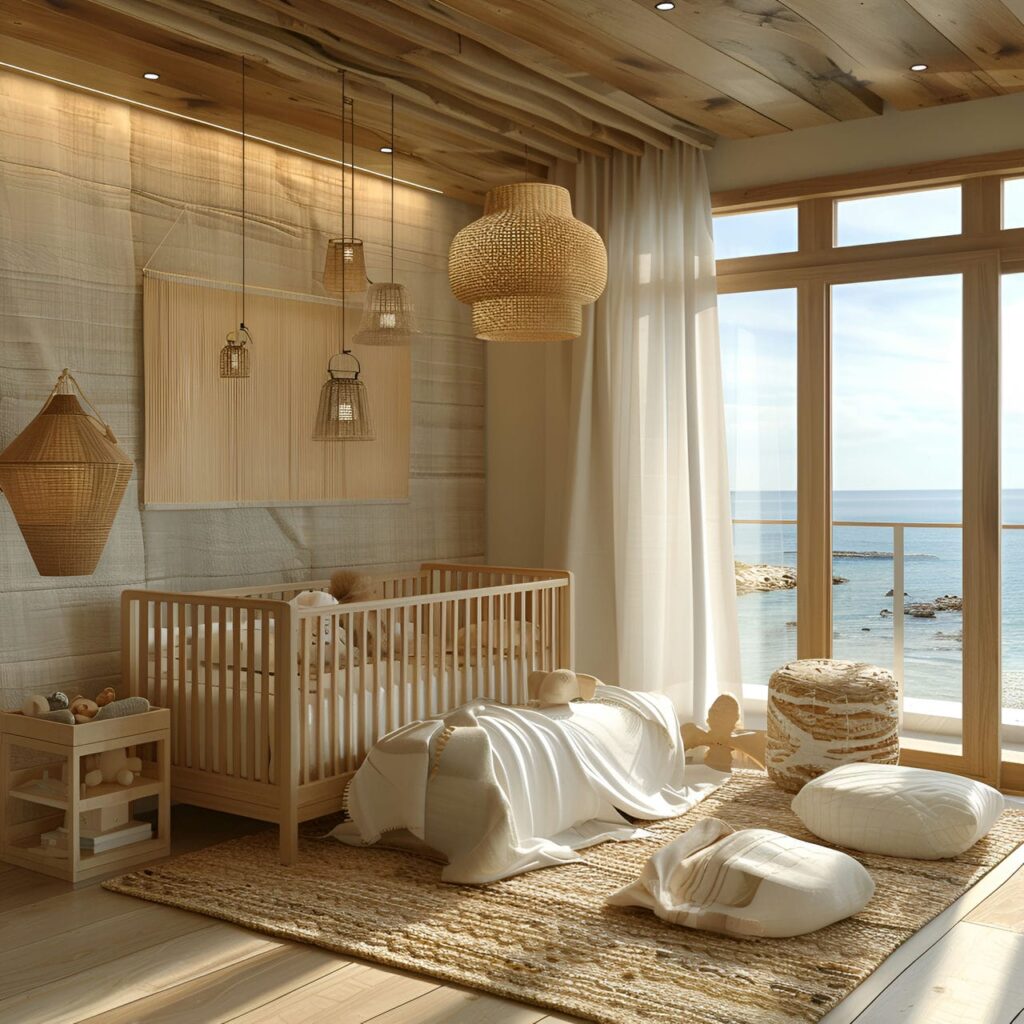
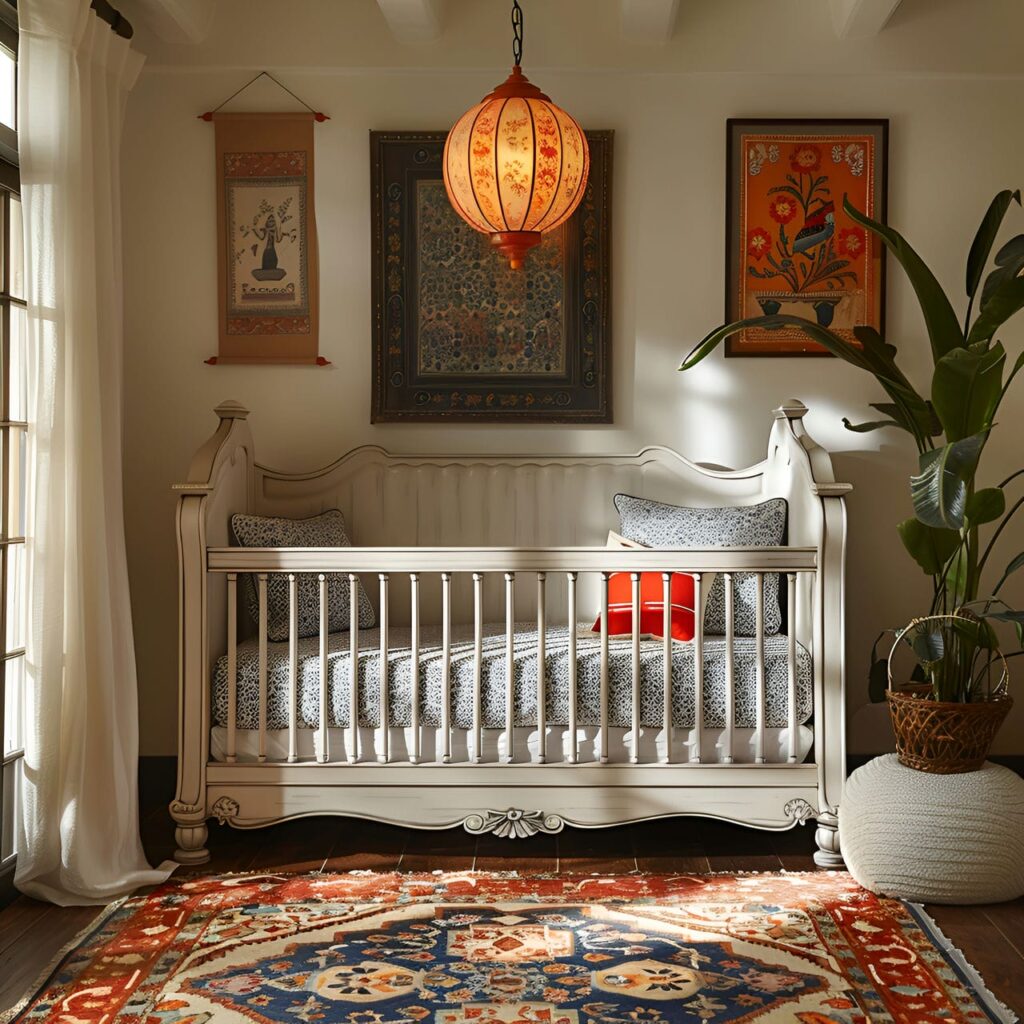
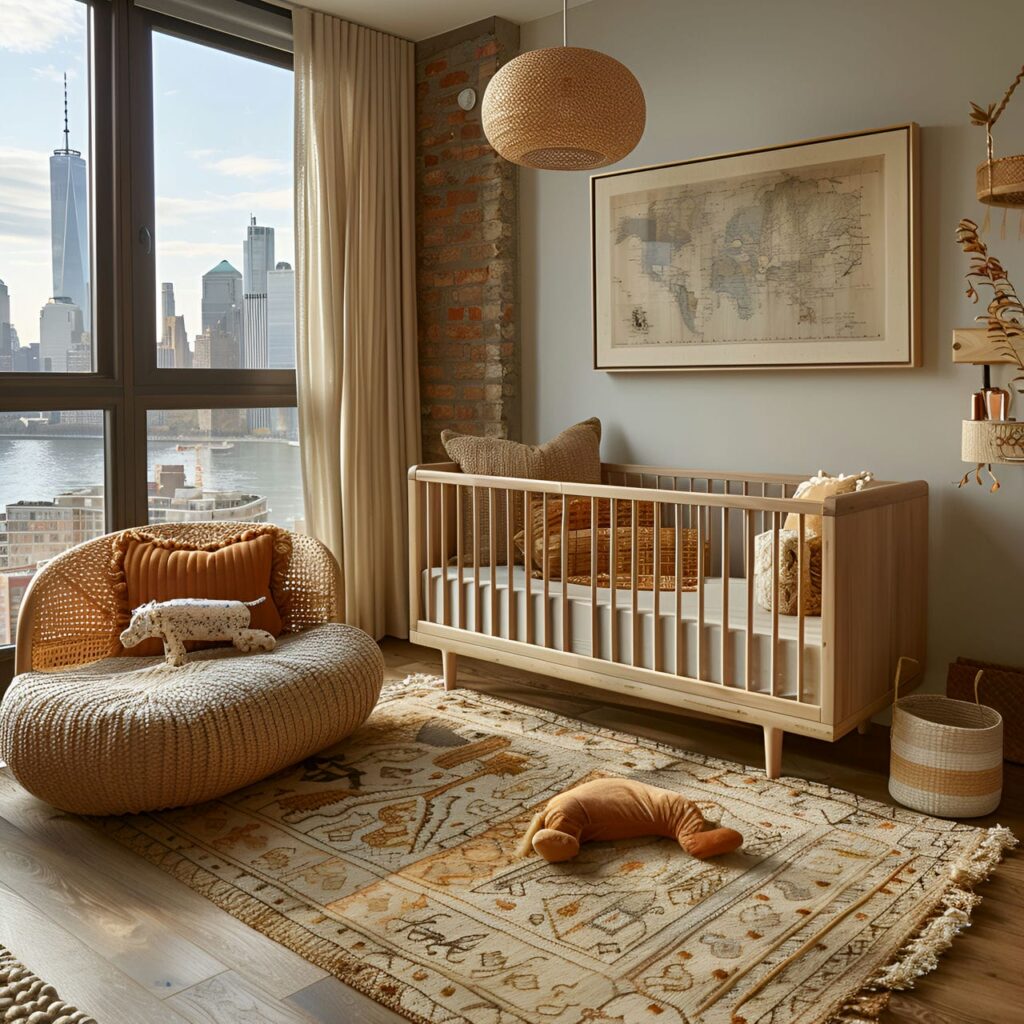
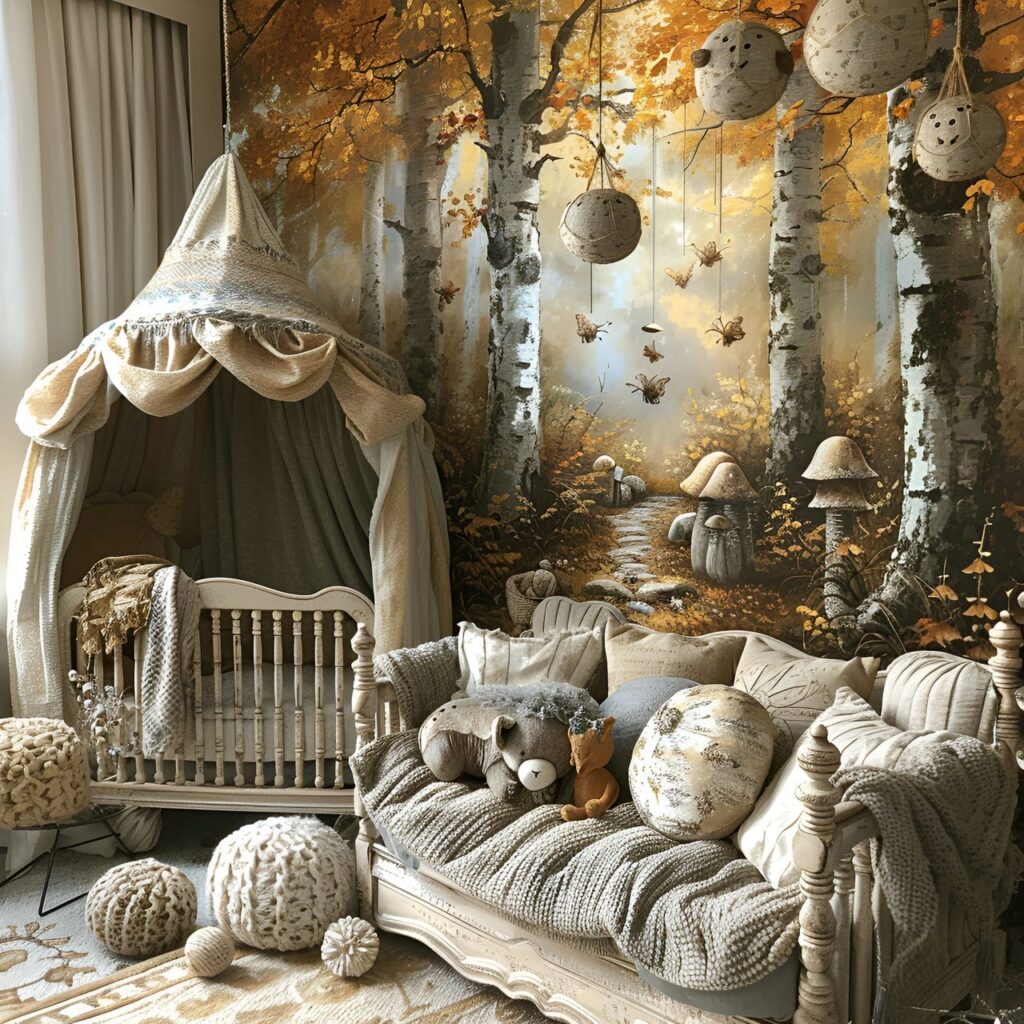
What are the struggles of the homeowner to redecorate a nursery?
Listed below are the struggles of the homeowner to redecorate a nursery:
- Balancing Function and Style: One of the main struggles homeowners face when redecorating a nursery is finding a balance between function and style. The nursery needs to be safe and practical for the baby, but homeowners want it aesthetically pleasing. This can be a challenge, especially for new parents who may need to gain experience in interior design or childproofing a room.
- Influence of Social Media: Social media and influencer culture can pressure homeowners to go overboard with nursery decorations. This can lead to unnecessary expenses and a room more focused on appearance than functionality.
- Cost of Decorations: The cost of nursery decorations can be a significant struggle for homeowners. Designer items can be expensive, and homeowners may feel pressured to create a high-end look.
- Choosing the Right Color Scheme: Choosing a suitable color scheme for a nursery can be challenging. The color should be calming, peaceful, colorful, and stimulating for the baby. Homeowners may need help finding the right balance and feel limited to traditional pastel colors.
- Room Transformations: Transforming a room into a nursery can be complex. It involves more than just decorating; it may also involve demolition or construction work. Homeowners may need help with the physical aspects of the transformation, as well as the planning and design stages.
- Planning for Future Changes: A nursery is not a permanent room; it must be redecorated as the child grows. Homeowners may need help with planning for these future changes. Choosing decorations and furniture that can be easily updated or repurposed is important.
- Working with a Limited Budget: Many homeowners work with a limited budget when redecorating a nursery. This can make achieving the desired look and feel for the room challenging. Homeowners may need to prioritize certain aspects of the decoration and make compromises to stay within their budget.
